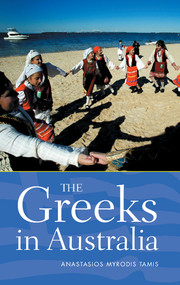4 - Social and Community Life
Published online by Cambridge University Press: 22 September 2009
Summary
The Greek community before World War II
Upon their arrival Greek immigrants had the tendency at first to seek the protection of their compatriots, heading for destinations determined by their employment needs. After 1880, the 450 or so dispersed Greeks commenced to settle in the inner suburban areas of the colonial capitals of Sydney (Paddington), Perth (Northbridge) and Melbourne (Carlton) to find accommodation and employment. There they formed small communes of compatriots, working as street peddlers, street-vending labourers and kitchen hands in the restaurants and coffee houses owned by their compatriots. In the vast countryside, a small number of pioneer Greeks ware employed as railway construction workers and farm labourers recruited by agents of the companies needing their services. By the closing years of the nineteenth century, those living in the urban centres became aware of the need for a more permanent settlement in this vast country and decided to form their first Communities.
In 1892, an Orthodox Christian consortium composed of Greek, Russian and Syrolibanese settlers commenced negotiations with Russia, Greece and the Patriarchate of Jerusalem to establish the first Orthodox Church in Australia (Tamis, 2000). Following seven years of negotiations, involving the Russian and Greek consular representatives, Community leaders and the Anglican Church of Australia their vision finally matured. On 22 August 1897 the leaders of the 100 Greeks in Melbourne, in collaboration with the Syrolibanese settlers, called a meeting and founded the Greek Orthodox Church [Community] of Melbourne. Founding members included Alexander Maniakis, Antonios Lekatsas and Grigorios Matorikos.
- Type
- Chapter
- Information
- The Greeks in Australia , pp. 67 - 116Publisher: Cambridge University PressPrint publication year: 2005



